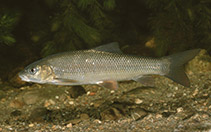| Family: |
Cyprinidae (Minnows or carps), subfamily: Barbinae |
| Max. size: |
60 cm TL (male/unsexed); max.weight: 3,000.0 g |
| Environment: |
benthopelagic; freshwater |
| Distribution: |
Europe: Greece from Kalamas to Mornos (except Acheron) and Pinios drainages (Pelopennese), including Lakes Trichonis, Amvrakia and Pamvotis. Despite its scientific name, this species is not found in Albania. |
| Diagnosis: |
Dorsal soft rays (total): 8-8. Diagnosed from other species of Barbus and Luciobarbus in Balkan Peninsula by having the following combination of characters: last simple dorsal ray slender, spinous and serrated posteriorly along half to entire length; posterior margin of dorsal fin straight; lower lip thin, without median lobe in most individuals; thick lips with median lobe in some individuals; 48-55 + 2-3 scales on lateral line; 20-24 scales rows around caudal peduncle; and snout with large tubercles in large individuals (Ref. 59043). |
| Biology: |
A long-lived species which occurs in lentic waters (Ref. 26100). Inhabits lakes and lower course of rivers, with mud to sand bottom. Feeds on algae, plant material, insect larvae and detritus. Spawns in both lakes and their tributaries. Individual females spawn with 3-7 males on sandy beaches, especially near estuaries of tributaries. Larvae and juveniles form small monospecific schools in bays and harbours (Ref. 59043). Threatened due to habitat destruction and pollution (Ref. 26100). |
| IUCN Red List Status: |
Least Concern (LC); Date assessed: 01 January 2008 Ref. (130435)
|
| Threat to humans: |
harmless |
| Country info: |
|
Source and more info: www.fishbase.org. For personal, classroom, and other internal use only. Not for publication.

